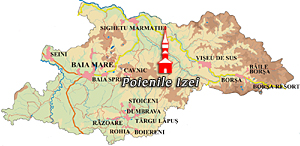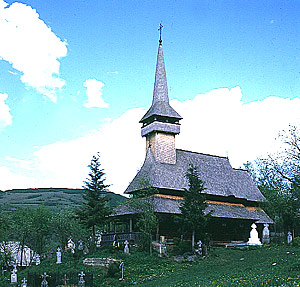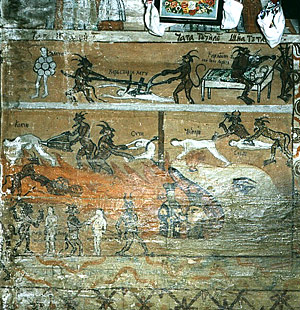Poienile Izei Church

Year built: 1604-1632
Location: Poienile Izei
Summary: The church was built with fir beams. The square chancel is narrower than the rectangular plan of the main body of the church, as is typical for the older churches. From constructional details it has been deduced that the original church was much lower, and that it was made higher in the 18th century. The church is one of the eight churches on UNESCO’s World Heritage List.

A roof with double eaves covers the church, although the chancel has its own slightly lower roof, as is usual. The porch, which was added at a later date, is covered with its own protruding roofing. A tall tower with a conical roof crowns the church.
Gheorghe of Dragomireşti painted the church in the post-Byzantine tradition in 1794. The paintings are very well preserved, and include big scenes in simple frames. The colours is more important for the unity of the paintings than the actual composition of the scenes. The painted inscriptions are full of information on the period when the Habsburg Emperor Francis ruled.
The entrance to the church is through beautifully painted double doors, whose upper part shows the figures of Saints Peter and Paul, and the lower parts climbing vines. Also the very wide doorframe is decorated with climbing plants and an angel on each side of the door.

The main theme of the pronaos is The Last Judgment, one of the most complex renderings of this theme in Maramure[. Various groups are shown facing the judgment, as usual many foreigners among the damned, such as Turks, Tatars, Arabs and Gypsies, and dishonest people, such as liars, cheaters and the covetous. The scene covers not only the west wall, but also the north and south ones. At some point in time, openings were cut into the wall between the pronaos and the naos to allow everyone in the church to attend the ceremonies.
The interior space of the naos is extremely high. The barrel vault has been narrowed by the use of beams on either side. On the vault there is the representation of The Holy Trinity. On the walls there are the usual New Testament scenes depicting The Life and Passion of Christ. There are also numerous scenes from the Old Testament. A scene, which is unique in the area, represents Jesus as a pelican that feeds its small with his heart’s blood.



